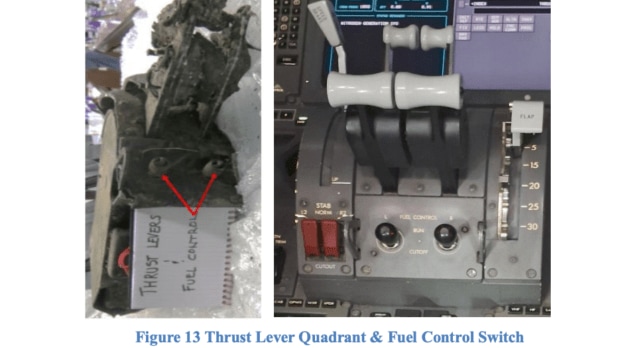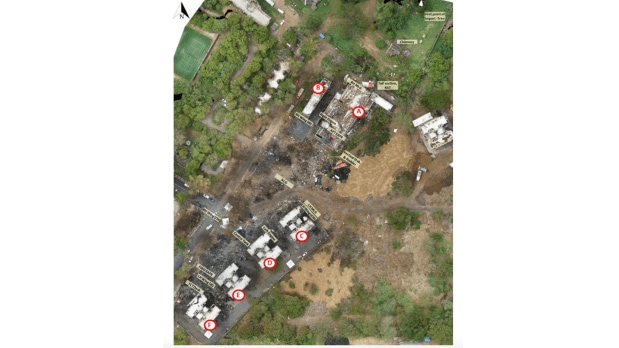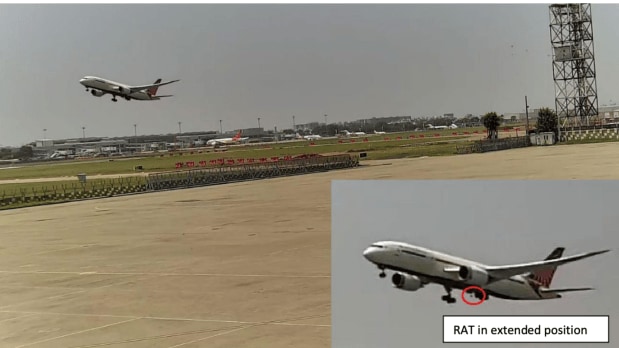Ahmedabad plane crash: The Aircraft Accident Investigation Bureau (AAIB) late Friday published its 15-page preliminary report on the doomed Air India flight, AI 171, that killed 260 people in Ahmedabad on June 12. The report reveals shocking details about the Boeing 787, including the rapid transition of fuel switches from “Run” to “Cutoff” – switch was recovered in Run mode from crash site, the Mayday call issued just two minutes after the aircraft was cleared for takeoff from Runway 23, and the subsequent failure of the second engine.
According to the report, both pilots were based in Mumbai and had sufficient rest after arriving in Ahmedabad the previous day. The co-pilot was Pilot Flying (PF), and the PIC was Pilot Monitoring (PM) for the flight, the report said.
The fuel and take-off weight were within the permissible limits. Additionally, no “dangerous goods” were on the aircraft.
Engine 2 experienced a problem
The most damning detail is that after the lift-off from the airport, the aircraft began losing altitude because the fuel switches transitioned from “Run” to “Cutoff”. The time difference between the two transitions was just one second. At around 1:38:32 pm IST, the position of the first engine’s fuel switch changed. Consequently, both engines started to decelerate from takeoff thrust values due to the fuel supply being cut off.
“Engine 1’s core deceleration stopped, reversed and started to progress to recovery. Engine 2 was able to relight but could not arrest core speed deceleration and re-introduced fuel repeatedly to increase core speed acceleration and recovery,” the report stated.
The above paragraph from the AAIB report confirms that Engine 1 initially lost power, but then it stabilised and started to regain normal operation. Although Engine 2 did restart after losing power, it couldn’t regain a stable core speed or thrust. So, was there a known issue with the second engine?
The AAIB report also supports earlier investigative pieces that there was a dual-engine failure at the same time.
‘Why did you cut off the fuel?’
The report contains another startling detail. When the fuel switches transitioned, one of the pilots asked the other why he had done so. The other pilot responded that he had not cut off fuel supply to the engines.
This part, based on cockpit recording, contradicts earlier claims that the pilots followed standard operating procedures (SOP) during the emergency, regarding the transition of fuel switches. It suggests that the switches may have transitioned on their own.
However, this also raises further questions: Why did one pilot believe the other had shut off the fuel supply? And more importantly, how could the fuel switches have transitioned automatically, if that indeed happened?

‘Aircraft started falling even before leaving airport premises’
Although the aircraft crashed outside the boundary of the Ahmedabad Airport, it began to lose altitude even before crossing the airport perimeter wall. The AAIB reached this conclusion after analysing the CCTV footage it obtained from the airport.
The aircraft started falling at the rate of 475 feet per minute. This abrupt fall happened after the aircraft reportedly reached an altitude of 625 feet.
Since the engine couldn’t reignite and the Boeing 787 was losing altitude, it first hit a series of trees, then the incineration chimney inside the Army Medical Corps compound, before impacting several buildings and catching fire. The report noted that five buildings sustained major structural and fire damage.
The wreckage, from the first impact point to the final identified aircraft part, was scattered across an area of approximately 1,000 ft by 400 ft. The below image shows the parts of aircraft scattered across the crash site.

RAT was deployed
Several reports based on investigators and aviation experts had suggested the deployment of Ram Air Turbine (RAT) during the initial climb, given the suspected dual-engine failure. The preliminary report confirms this.
It also shared screengrabs from the CCTV footage it accessed from the airport that shows RAT getting deployed. “As per the EAFR data, both engines’ N2 values passed below minimum idle speed, and the RAT hydraulic pump began supplying hydraulic power at about 08:08:47 UTC (1:38:47 pm IST),” the AAIB report on the crash further stated.
RAT is the aircraft’s emergency power system generator, which provides enough power to an aircraft and assists in landing during emergencies. Despite its deployment, the aircraft still crashed. This raises the question: Did the RAT fail to function as intended? If so, why?

The report also noted that the Emergency Locator Transmitter (ELT) did not activate when the aircraft crashed into the BJ Medical College. The ELT is designed to activate automatically upon significant impact or manually. Its failure to activate points to a possible malfunction of the system.
Mayday call in two minutes
The report provides a timeline of events based on ATC (Air Traffic Control) recordings. The AI 171 requested pushback and startup at around 1:13 pm IST. Thirteen seconds later, ATC approved the request. Three minutes later – at 1:16:59 pm IST – ATC approved the startup.
ATC then inquired whether the aircraft needed the full length of the runway. The crew confirmed. The aircraft used the full 3.5-km length of Runway 23.
At 1:25:15 pm IST, the ATC gave taxi clearance to the aircraft upon request.
Then the aircraft was transferred from ground to tower control and instructed to line up on Runway 23.
It received takeoff clearance at 1:37:33 pm IST. And, two minutes later, at 1:39:05 pm IST, the Mayday call was issued.
“At about 08:09:05 UTC (1:39:05 pm IST), one of the pilots transmitted: ‘Mayday, Mayday, Mayday’,” the report said.
It was earlier reported that the pilot, in its Mayday call to ATC – the highest-level, life-threatening signal- stated: “Mayday… no thrust, losing power, unable to lift.”
‘ATCO did not get a response but…’
AAIB, in its report with 13 subheads, stated that soon after the pilot’s Mayday call, an ATCO attempted to confirm the aircraft’s call sign but failed to establish communication with the cockpit.
“ATCO did not get any response but observed the aircraft crashing outside the airport boundary and activated the emergency response,” the report mentioned.
Clean chit to Boeing?
Since the preliminary report, which was made public 30 days after the crash, mentioned “no recommended actions” issued for Boeing or its 787-8 Dreamliner and its engine operators and manufacturers. This could imply that Boeing has been given a “clean chit” in the AI 171 crash.
If so, what about the known software issues in previous air accidents? Were they considered?
Although one aviation expert from the US told FinancialExpress.com that the TCMA failure could’ve caused the Boeing 787 crash. However, the report makes no mention of TCMA. Is TCMA also a factor?
TCMA (Thrust Control Malfunction accommodation) is basically a system that works alongside FADEC (Full Authority Digital Engine Control). TCMA informs FADEC whether the aircraft is on the ground or in the air, and if it believes the aircraft is on the ground, it may throttle back the engines automatically, without the input from the pilot.
“If the TCMA senses it is on the ground, it throttles back the engines without pilot input,” she further said, before adding, “On the Air India flight the fact that there are known computer problems causes me to suspect the Thrust Control Malfunction accommodation (TCMA) and the Full Authority Digital Engine Control (FADEC).”
You can read the entire report on TCMA here.
The report, at this moment, does not definitively identify the root cause of the crash. Many questions, particularly around the fuel switch transition, engine recovery failure, and Boeing 787 software glitches, remain unanswered.

